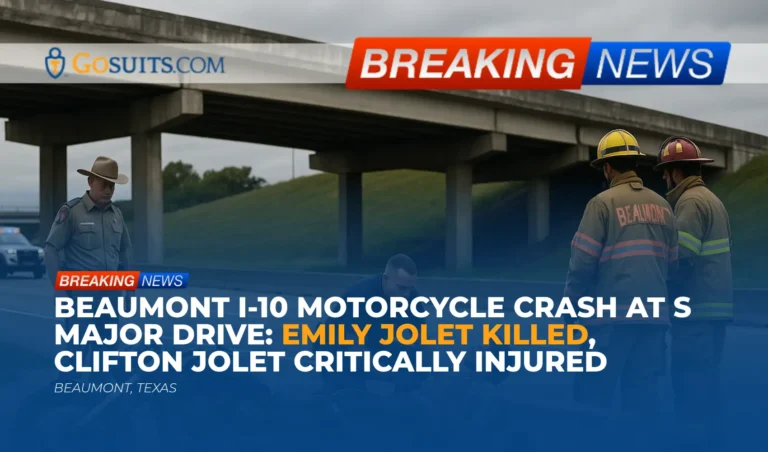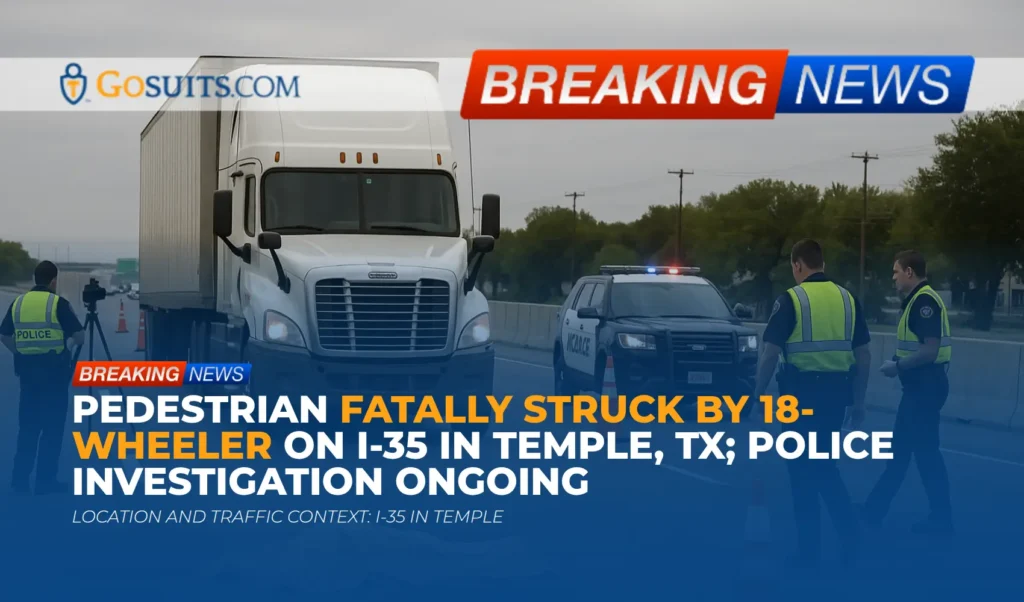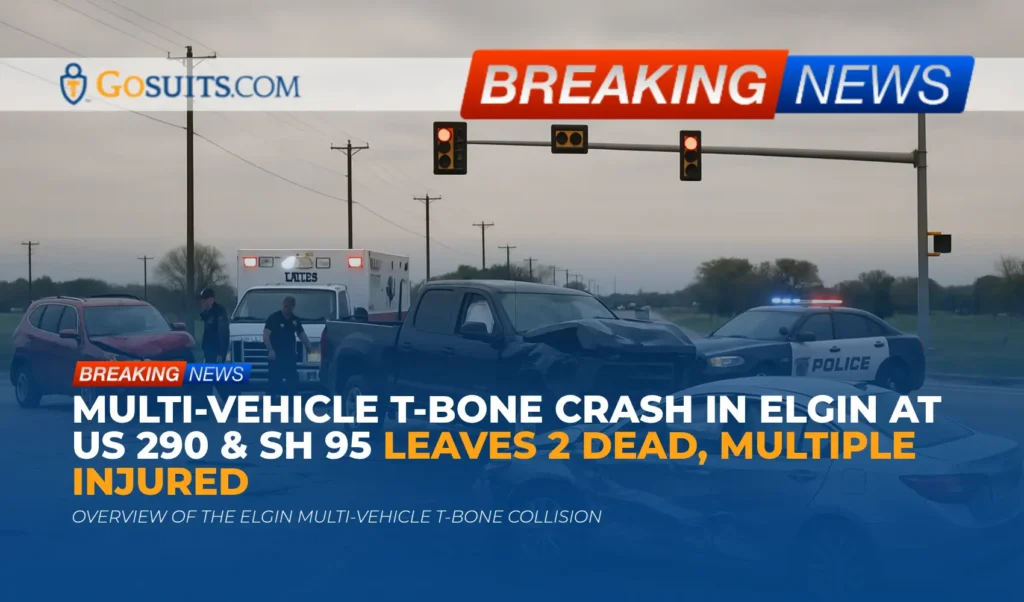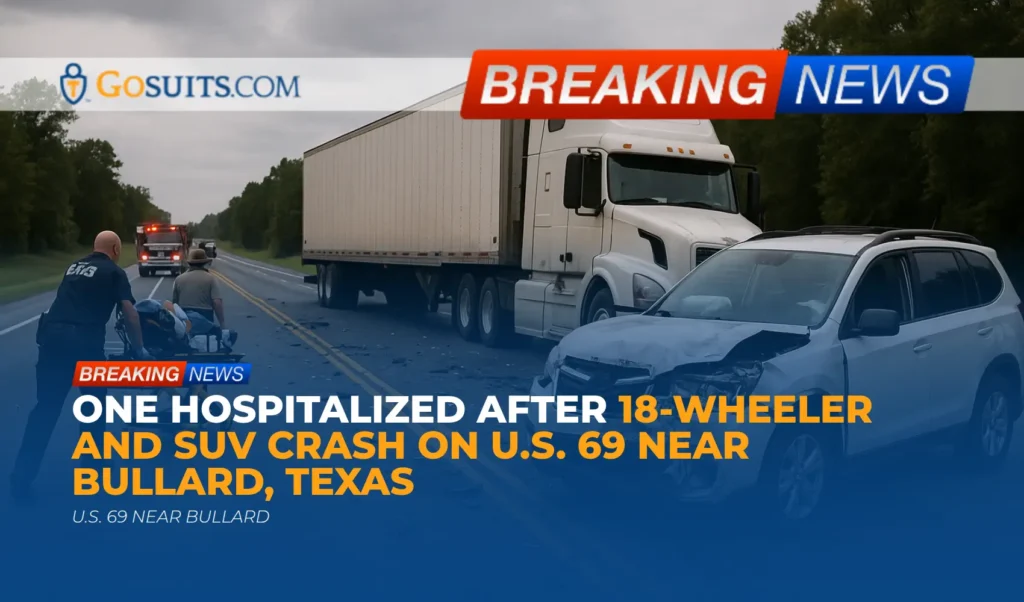- Incident overview and known facts
- Location context: I-10 at S Major Drive in Beaumont
- Immediate steps for families after a serious motorcycle crash in Texas
- How to obtain official records and documents
- Legal rights and potential civil claims in Texas
- Insurance considerations in single-vehicle motorcycle crashes
- Safety context and motorcycle risk data
- Possible contributing factors and evidence to preserve
- Supportive resources and practical guidance for families
- Commentary from Gosuits Beaumont, Texas Personal Injury Attorney
- Action steps and timing: why acting promptly matters
Incident overview and known facts
Early this morning in Beaumont, a tragic motorcycle crash on I-10 southbound at S Major Drive resulted in the death of a 31-year-old passenger, Emily Jolet of Chambers County, and left the 41-year-old operator, her husband, Clifton Jolet of Chambers County, in critical condition. Authorities reported that the motorcycle left the roadway and struck a concrete culvert, ejecting both individuals. Emily was pronounced deceased at the scene. Clifton was transported to a hospital with critical injuries. Justice of the Peace Ben Collins Sr. ordered an autopsy.
At this time, publicly available information indicates a single-vehicle event in which the operator lost control. Further investigative details, such as contributing factors, vehicle condition, roadway conditions, speed, or potential involvement of other drivers, have not been released. As with all serious crashes, a thorough investigation typically includes scene documentation, witness statements if available, and inspection of the motorcycle and roadway.
Our hearts are with the family, friends, and community members affected by this loss and with the injured survivor who is undergoing medical treatment.
Location context: I-10 at S Major Drive in Beaumont
Interstate 10 is a high-speed corridor through Beaumont, carrying heavy local and through traffic. The interchange at S Major Drive combines on- and off-ramps, lane shifts, and concrete structures such as culverts and barriers. In these areas, minor deviations from the roadway can have severe consequences due to limited runoff area and fixed objects close to travel lanes.
In a single-vehicle motorcycle crash near fixed roadside objects, factors that investigators often review include roadway curvature, surface condition and debris, lighting and visibility, weather at the time, signage and markings, and whether any evasive maneuvers were taken due to potential interactions with other vehicles. It is important not to presume a cause absent official findings.
Immediate steps for families after a serious motorcycle crash in Texas
When a family is notified of a fatal or critical-injury crash, the first priorities are information, support, and preservation of important documents and evidence. The steps below are general, compassionate guidance to help families navigate the first days and weeks following a tragedy.
Health, safety, and support
- Seek medical and emotional care. Focus on urgent medical needs and emotional support. Hospitals typically provide a social worker or liaison to help families with updates, visitation policies, and next steps.
- Designate a point of contact. Choose a trusted family member to communicate with law enforcement, healthcare providers, and, if appropriate, a legal representative to reduce repeated retellings during a difficult time.
Information gathering
- Request the incident number. Ask responding law enforcement for the crash report number. This helps when requesting official records later.
- Preserve documents. Keep hospital discharge summaries, EMS run sheets if provided, funeral home documents, and any personal photos or messages that may be relevant.
- Note potential witnesses. If anyone reached out claiming to have seen the crash, write down their name and contact details and provide this to investigators.
Preserving evidence
- Secure the motorcycle and gear. The motorcycle, helmet, jacket, and other protective gear can contain important evidence. If the vehicle has been towed, find out where it is stored and ask that it be preserved.
- Avoid repairs or disposal. Do not authorize repairs or disposal before an inspection can occur. Photographs of the scene, vehicle damage, and gear can assist in reconstructing events.
Insurance communications
- Speak with an attorney before recorded statements. Insurance adjusters may request a recorded statement. What is said can be used later to limit coverage. It is wise to consult a qualified attorney first to understand rights and obligations.
- Gather policy information. Collect auto and motorcycle insurance policies for all household vehicles, health insurance cards, and any optional coverages such as Personal Injury Protection or uninsured/underinsured motorist coverage.
How to obtain official records and documents
Official documents can clarify what happened and are often necessary for claims and benefits. Availability and eligibility to receive copies are controlled by Texas law.
Texas crash report (CR-3)
In Texas, officers must complete a written crash report for qualifying crashes. See Texas Transportation Code §550.062. Access to crash reports is governed by §550.065, which identifies who may obtain a copy, including involved parties and their authorized representatives.
- How to request: Eligible requestors can purchase the official CR-3 crash report through the Texas Department of Transportation’s Crash Records Information System (CRIS). Visit TxDOT crash reports portal.
- What you need: Names of involved parties, crash date, and location or the law enforcement incident number.
Autopsy and inquest records
In counties without a medical examiner, a Justice of the Peace conducts an inquest when a death occurs from an unnatural cause and may order an autopsy. See Texas Code of Criminal Procedure Art. 49.04 and Art. 49.10. Justice of the Peace Ben Collins Sr. has ordered an autopsy in this matter.
- What to expect: Autopsy findings can take weeks depending on toxicology and laboratory analysis. Next of kin can typically request information once reports are finalized, subject to applicable confidentiality rules.
- Where to inquire: The Justice of the Peace office that ordered the inquest can advise on the process to request autopsy or inquest records.
Death certificates
Certified death certificates are issued by the Texas Department of State Health Services Vital Statistics Section. Guidance for requesting records is available from Texas DSHS Vital Statistics. Funeral homes often assist families with initial filings.
911 audio and CAD logs
Computer-aided dispatch logs and 911 recordings may be available through the responding agency, subject to the Texas Public Information Act and privacy laws. The agency’s records division can explain request procedures.
Medical records
Hospitals and EMS providers maintain records for treatment and transport. Next of kin for a decedent or the injured patient can request records per HIPAA and state law. Keep photo identification and proof of relationship available when making requests.
Legal rights and potential civil claims in Texas
The civil law aspects of a serious motorcycle crash often involve multiple avenues for accountability and financial recovery. Because each case is unique, the points below are general educational information based on Texas statutes.
Wrongful death and survival claims
- Who may bring a wrongful death claim: In Texas, the deceased person’s surviving spouse, children, and parents may bring a wrongful death action. See Texas Civil Practice and Remedies Code §71.004.
- Survival action: The decedent’s estate may bring a survival claim for damages the decedent could have recovered if they had lived. See §71.021.

Potential liability paths in a single-vehicle motorcycle crash
Even when only one vehicle is reported, liability analysis can extend beyond the operator. Examples include:
- Roadway conditions such as hazardous debris, inadequate signage, or defective design or maintenance.
- Phantom or unidentified vehicles whose actions cause a rider to take evasive action and leave the roadway.
- Defective components including tire failure, brake defects, or other mechanical issues.
- Third-party negligence related to cargo spills, construction zone control, or improper roadside hazard placement.
Investigations typically examine these possibilities through scene analysis, vehicle inspection, and any available witness or camera evidence.
Comparative fault rule
Texas uses a modified comparative responsibility rule. A claimant barred from recovery if they are more than 50 percent responsible for the harm; otherwise, recoverable damages may be reduced by the claimant’s percentage of responsibility. See Texas CPRC §33.001.
Time limits
Most Texas personal injury and wrongful death claims must be filed within two years of the injury or death, subject to exceptions. See Texas CPRC §16.003. Because calculating deadlines can be complex, timely evaluation is important.
Insurance considerations in single-vehicle motorcycle crashes
Insurance coverage analysis often guides immediate financial options for medical bills, funeral expenses, and other losses. Policies should be reviewed carefully.
Common coverages that may apply
- Personal Injury Protection (PIP): In Texas, insurers must offer PIP on auto policies; if accepted, PIP can cover medical expenses and some lost income regardless of fault. The Texas Department of Insurance provides consumer guidance on auto coverages at tdi.texas.gov.
- Medical Payments (MedPay): Optional coverage for medical costs up to the policy limit, regardless of fault.
- Uninsured/Underinsured Motorist (UM/UIM): Can apply if an unidentified or uninsured driver contributed to the crash, including “miss-and-run” scenarios where a rider swerves to avoid another vehicle.
- Liability coverage: If a passenger is injured or killed, the operator’s liability coverage may be implicated, depending on fault allocation and policy terms.
- Health insurance: Helps with medical bills while liability is investigated, subject to coordination of benefits and potential subrogation.
Practical tips for working with insurers
- Consult an attorney before calling insurers for a recorded statement. Statements can be used to minimize or deny claims. Understanding rights and obligations first is prudent.
- Collect all household policies. Multiple policies within a household may offer overlapping protections, including UM/UIM stacking in certain circumstances depending on policy language.
- Document expenses. Keep receipts for medical bills, funeral costs, travel to medical appointments, and wage documentation to support claims.
Safety context and motorcycle risk data
The loss described here reflects broader patterns in highway safety data for motorcyclists, who face elevated risks due to limited protection and exposure to roadside hazards. Public safety agencies publish data that helps families understand the context of these tragedies.
Helmet effectiveness
- Reduced risk of death and head injury: According to the Centers for Disease Control and Prevention, motorcycle helmets reduce the risk of head injury by 69 percent and the risk of death by 37 percent. See CDC’s motorcycle safety page at cdc.gov.
- Passenger protection: National analyses show helmets are protective for both riders and passengers. NHTSA reports helmet use substantially reduces fatal injury risk among motorcyclists. See NHTSA’s motorcycle safety overview at nhtsa.gov.
Texas law generally requires motorcycle helmet use, with limited exemptions for riders age 21 and older who meet statutory training or insurance criteria. See Texas Transportation Code Chapter 661. This background is provided for context and is not a comment on any individual’s compliance.
Motorcyclist risk on high-speed roadways
- Overrepresentation in fatalities: Federal traffic safety data consistently show motorcyclists are overrepresented in fatal crashes relative to their share of vehicle miles traveled. See NHTSA motorcycle safety resources at nhtsa.gov.
- Fixed-object impacts: When a motorcycle leaves the roadway, impacts with fixed objects such as culverts, guardrails, or barriers are often severe because riders lack a protective cage and can be ejected.
Why investigations take time
Crash investigators may review scene measurements, tire marks, vehicle damage patterns, roadway design specifications, visibility and lighting, and any available dash cameras or traffic cameras. Autopsy and toxicology results requested in an inquest also contribute to the factual record. These steps help determine whether any party’s negligence or a defective condition contributed to the outcome.
Possible contributing factors and evidence to preserve
Without speculating about this crash, below are examples of information that often proves vital in determining what happened and whether a third party bears responsibility. Preserving these items early can be crucial.
- Roadway evidence: Photographs of the scene, skid or yaw marks, gouge marks, debris fields, and the location of the concrete culvert or other fixed objects.
- Visibility evidence: Lighting conditions, presence of construction zones, missing or obscured signage, and vegetation that may obstruct sightlines.
- Vehicle condition: Tire condition and pressures, brake function, throttle and steering components, and any service history relevant to mechanical integrity.
- Protective gear: Helmets and jackets can show impact forces and strike zones that help reconstruct events.
- Third-party involvement: Reports of another vehicle cutting off or crowding the motorcycle, even if no physical contact occurred, can be critical for UM/UIM considerations.
- Digital evidence: Traffic camera footage, nearby business surveillance, and personal dash cameras. Many systems overwrite in days, so timely requests matter.
- Emergency response timelines: EMS run sheets, dispatch logs, and hospital records documenting injuries and treatment.
Supportive resources and practical guidance for families
Families often ask where to turn for reliable information and assistance. Below are practical avenues tied to Texas public agencies and processes.
- Crash report: Request through TxDOT’s online portal at TxDOT crash reports portal. Eligibility is defined by Texas Transportation Code §550.065.
- Autopsy and inquest: Contact the Justice of the Peace office that ordered the autopsy to learn about timeline and release of findings. Authority for inquests and autopsies is set out in Texas Code of Criminal Procedure Art. 49.04 and Art. 49.10.
- Death certificates: Obtain certified copies through the Texas Department of State Health Services Vital Statistics: DSHS death records.
- Insurance guidance: The Texas Department of Insurance provides consumer information about auto coverages, claims, and complaint processes at tdi.texas.gov.
- Crash data and safety information: Federal safety context, including motorcycle risk and helmet effectiveness, is available from NHTSA at nhtsa.gov and CDC at cdc.gov.
In addition, local law enforcement agencies’ records divisions can explain how to request 911 audio and CAD logs. If a construction zone or public roadway design may have contributed, maintenance and construction records may be held by TxDOT or a local transportation agency; timely public information requests may be necessary to preserve evidence.

Commentary from Gosuits Beaumont, Texas Personal Injury Attorney
First and foremost, we extend our deepest condolences to the loved ones of Emily Jolet and our genuine hopes for the recovery of Clifton Jolet. Incidents like this weigh heavily on the community. The thoughts below are offered for educational purposes and general information, not as case-specific advice.
From a civil injury perspective, even when a crash is reported as a single-vehicle event, it is important to keep an open mind about potential contributing factors that may not be obvious on day one. Thorough investigations often consider roadway design and maintenance near fixed objects like culverts, the presence of debris, potential evasive actions in response to other motorists, and mechanical conditions. Ensuring timely access to the motorcycle, protective gear, and official records can make a meaningful difference in understanding what happened.
In our experience, insurance carriers and large corporations move quickly after a serious crash. Adjusters may contact families seeking recorded statements or quick resolutions before the full picture is known. Policy language can be complex, and statements made under stress can be used later to restrict coverage or shift responsibility. Consulting with a seasoned and skilled attorney before speaking with insurers can help level the playing field, safeguard rights, and identify all available sources of recovery, including coverages that are sometimes overlooked.
It is also important to understand the value of a no-cost initial consultation. These conversations empower people with knowledge about timelines, evidence preservation, insurance coordination, and options under Texas law without requiring a commitment. Acting promptly can help ensure that critical evidence is preserved and that deadlines are met while families focus on healing and remembrance.
Action steps and timing: why acting promptly matters
The aftermath of a severe crash is overwhelming. Yet certain steps, taken sooner rather than later, can protect important rights and clarify options. The following guidance explains what actions are beneficial, why timing matters, and what outcomes early action can support.
- Secure official records quickly. Request the Texas CR-3 crash report from TxDOT once available. Early access helps inform insurance claims and guides further evidence requests. Crash data portals and statutes governing access are public and straightforward to navigate for eligible requestors.
- Preserve the motorcycle and gear. Arrange for the motorcycle and protective gear to be stored without alteration until a qualified inspection can occur. Early preservation supports accurate reconstruction and ensures that potential product defects or other contributing factors are not lost.
- Identify and request video evidence. Traffic cameras, nearby business surveillance, and dash cameras often overwrite within days. Prompt identification and requests can capture crucial footage while it still exists.
- Document expenses and losses. Maintain a dedicated file for medical bills, funeral and memorial costs, travel expenses for hospital visits, and wage records. Detailed documentation helps ensure that available insurance coverages are properly applied.
- Coordinate with healthcare providers. Confirm points of contact at the hospital for updates and medical records. Consistent communication helps families understand treatment plans and timelines for medical documentation that may be needed for benefits or claims.
- Avoid recorded statements before legal guidance. Insurance statements taken early can be incomplete or imprecise. Because they may be used to limit benefits later, it is prudent to seek a free consultation with a qualified attorney before engaging in recorded conversations with adjusters.
- Be mindful of Texas deadlines. Most civil injury and wrongful death claims in Texas have a two-year limitations period, and some notice requirements are shorter, especially if a governmental entity could be involved. Early action helps identify any shortened notice periods and ensures compliance.
- Consider all insurance avenues. Review policies for Personal Injury Protection, MedPay, and UM/UIM. Early notice to applicable carriers can be necessary, but messaging should be carefully guided to avoid misunderstandings that affect coverage.
By acting promptly, families and representatives can improve the clarity of the factual record, avoid loss of time-sensitive evidence, and position themselves to make informed decisions about their next steps. Throughout that process, compassion and patience are essential, allowing space for grief and recovery while important protections are put in place.
Key references
- Texas Transportation Code §550.062 and §550.065 on crash reports and access
- TxDOT Crash Records Information System (CRIS)
- Texas Code of Criminal Procedure Art. 49.04 and Art. 49.10 on inquests and autopsies
- Texas DSHS Vital Statistics: death records
- Texas CPRC §71.004 and §71.021 on wrongful death and survival actions
- Texas CPRC §33.001 on comparative responsibility
- Texas CPRC §16.003 on limitations periods
- Texas Transportation Code Chapter 661 on motorcycle helmets
- NHTSA Motorcycle Safety
- CDC Motorcycle Safety
- Texas Department of Insurance






